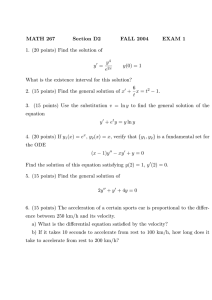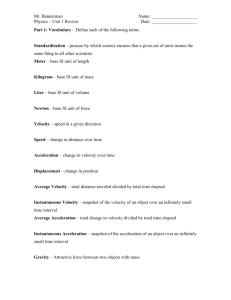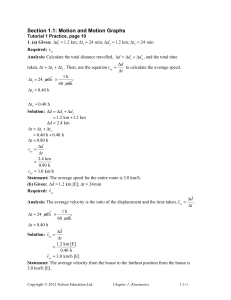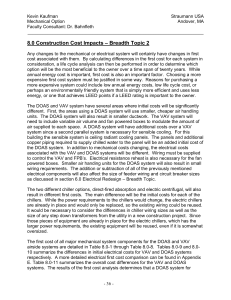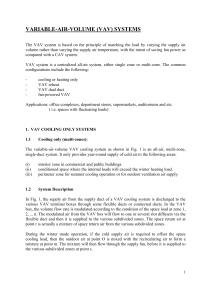Version PREVIEW – Practice 1 – carroll – (11108) 1 This print
advertisement
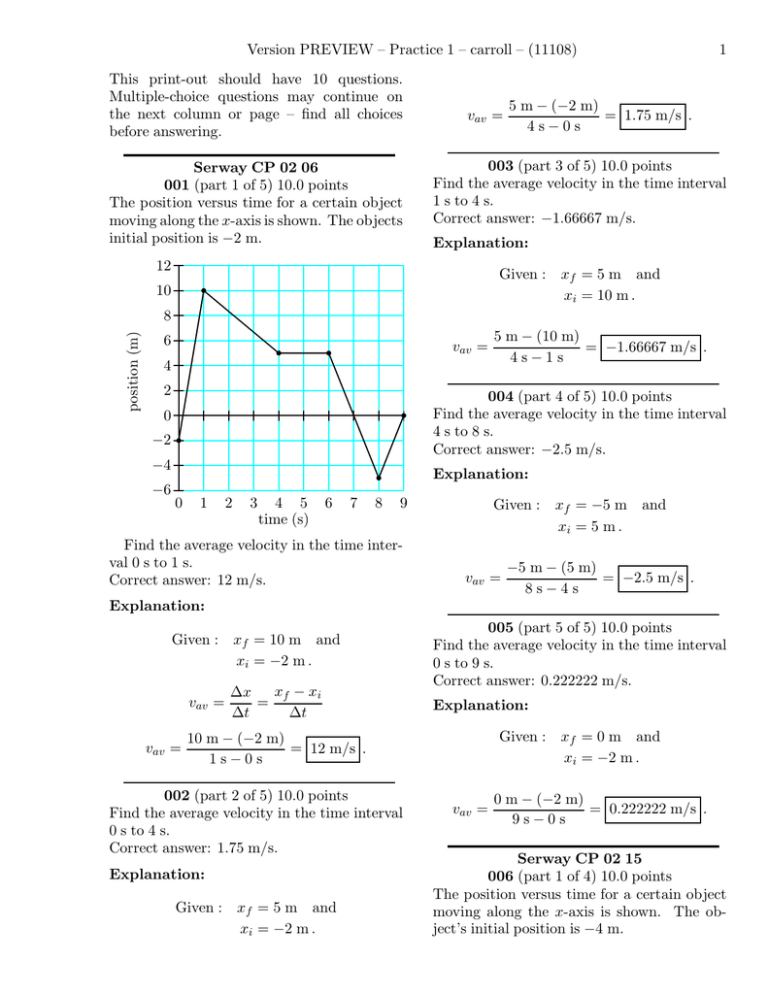
Version PREVIEW – Practice 1 – carroll – (11108) This print-out should have 10 questions. Multiple-choice questions may continue on the next column or page – find all choices before answering. vav = 5 m − (−2 m) = 1.75 m/s . 4s−0s 003 (part 3 of 5) 10.0 points Find the average velocity in the time interval 1 s to 4 s. Correct answer: −1.66667 m/s. Serway CP 02 06 001 (part 1 of 5) 10.0 points The position versus time for a certain object moving along the x-axis is shown. The objects initial position is −2 m. Explanation: 12 Given : xf = 5 m and xi = 10 m . b 10 1 position (m) 8 6 b vav = b 4 2 b 0 −2 b −4 −6 1 2 3 4 5 time (s) 6 7 8 004 (part 4 of 5) 10.0 points Find the average velocity in the time interval 4 s to 8 s. Correct answer: −2.5 m/s. Explanation: b 0 5 m − (10 m) = −1.66667 m/s . 4s−1 s 9 Find the average velocity in the time interval 0 s to 1 s. Correct answer: 12 m/s. Given : vav = xf = −5 m xi = 5 m . and −5 m − (5 m) = −2.5 m/s . 8s−4s Explanation: Given : xf = 10 m and xi = −2 m . vav = vav = xf − x i ∆x = ∆t ∆t 005 (part 5 of 5) 10.0 points Find the average velocity in the time interval 0 s to 9 s. Correct answer: 0.222222 m/s. Explanation: Given : xf = 0 m and xi = −2 m . 10 m − (−2 m) = 12 m/s . 1s−0 s 002 (part 2 of 5) 10.0 points Find the average velocity in the time interval 0 s to 4 s. Correct answer: 1.75 m/s. Explanation: Given : xf = 5 m and xi = −2 m . vav = 0 m − (−2 m) = 0.222222 m/s . 9s−0 s Serway CP 02 15 006 (part 1 of 4) 10.0 points The position versus time for a certain object moving along the x-axis is shown. The object’s initial position is −4 m. Version PREVIEW – Practice 1 – carroll – (11108) position (m) 6 b 4 b 2 b b 0 b −2 b −4 −6 0 1 2 3 4 5 time (s) 6 7 8 9 Find the instantaneous velocity at 1 s. Correct answer: 4.5 m/s. Explanation: The instantaneous velocity is the slope of the tangent line at that point. v= (5 m) − (−4 m) = 4.5 m/s . (2 s) − (0 s) 007 (part 2 of 4) 10.0 points Find the instantaneous velocity at 2.5 s. Correct answer: −3 m/s. 010 10.0 points The Stratosphere Tower in Las Vegas is 1193 ft high. It takes 2.9 min, 28 s to ascend from the ground floor to the top of the tower using the high-speed elevator. The acceleration of gravity is 9.81 m/s2 . Assuming that the elevator starts and ends at rest, and its acceleration has a constant magnitude when moving, find the acceleration of the elevator as a multiple of the acceleration of gravity. Correct answer: 0.00363348g. Explanation: Let : h = 1193 ft , t1 = 2.9 min + 28 s = 202 s , v0 = 0 , and g = 9.81 m/s2 . The elevator accelerates uniformly until the halfway point (where it reaches maximum speed) and decelerates uniformly until the top: Explanation: v= (2 m) − (5 m) = −3 m/s . (3 s) − (2 s) 008 (part 3 of 4) 10.0 points Find the instantaneous velocity at 4 s. Correct answer: 0 m/s. Explanation: v= (2 m) − (2 m) = 0 m/s . (5 s) − (3 s) 009 (part 4 of 4) 10.0 points Find the instantaneous velocity at 8 s. Correct answer: 1 m/s. Explanation: v= (0 m) − (−2 m) = 1 m/s . (9 s) − (7 s) Tipler PSE5 02 106 2 1 1 1 h = v0 ∆t + a (∆t)2 = a (∆t)2 2 2 2 h h 4h = 2 = 2 2 (∆t) t1 1 t1 2 4 (1193 ft) 1m = × 2 (202 s) 3.281 ft g × 9.81 m/s2 4 (363.609 m) = g (202 s)2 (9.81 m/s2 ) a= = 0.00363348 g .
